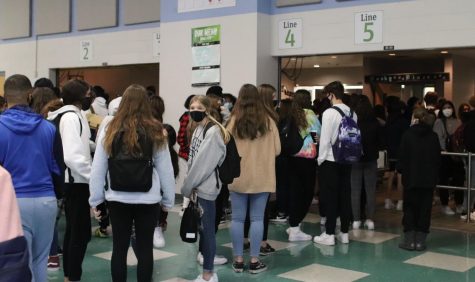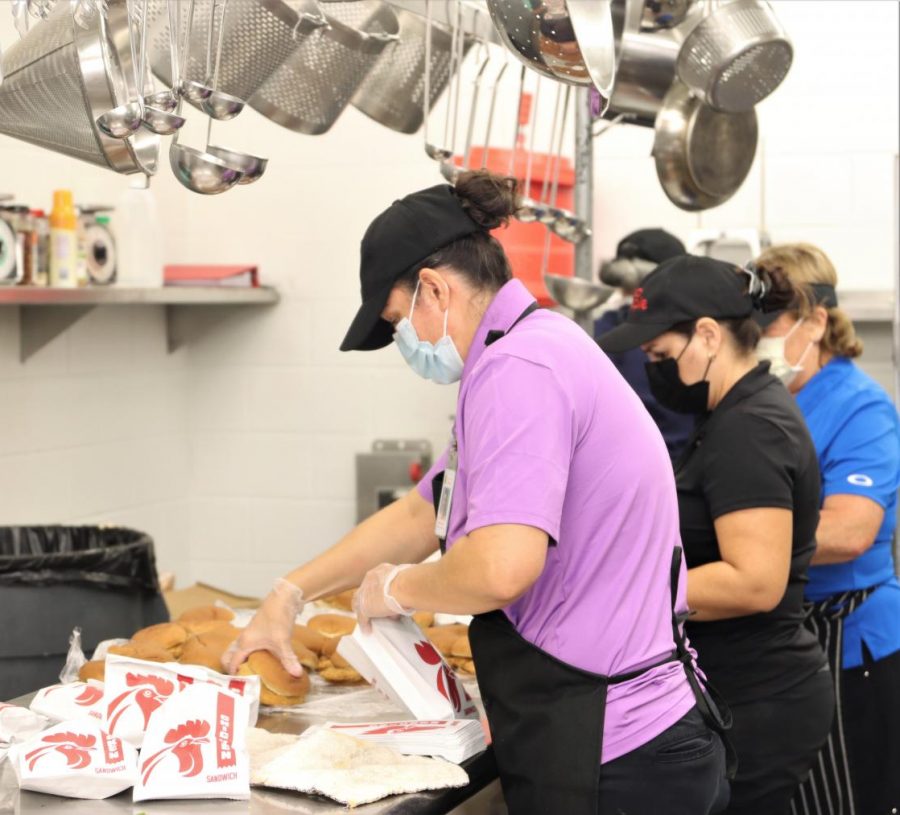Lunch lines and the labor shortage
How a nationwide problem lengthens lines
photo by Alexis Madlang
Cafeteria staff prepare chicken sandwiches for lunch. The staff prepare food three times a day for each meal opportunity on campus.
Lines, as a general rule, suck. Who willingly wants to wait for something? No one. But waiting is a part of life, and with the return of brick and mortar schooling, increasingly common. For students, long lunch lines are a primary offender.
Dining Services Restaurant Manager Erin Bastilo is the person in charge of the cafeteria – last year she was the friendly face at the entrance of lines, but this year she has to hustle in the kitchen more and more.
Bastilo is missing team members, forcing her to pick up the extra slack. She describes every day as a struggle.
“We are short four team members right now, forcing us to bring in a supervisor and secretary just to get enough food out on time. Most of the time we make it, just barely. Some days we aren’t so lucky – because we already have fewer people than we need, if anyone misses work we end up with the bloated lines that students walk out of.”
Until the cafeteria reaches full staffing, Bastilo wants to provide advice to those frustrated with long lines.
“Have patience. Have patience and understanding: one day it may be you having to deal with an overflow. I live in this area, I visit the local restaurants and oftentimes see students working in situations similar to this one. They look at me and I think they finally understand that everyone is just doing the best they can to deal with the shortage of labor.”
Labor shortages are not unique to Hagerty. As cafeteria staff struggle to fill open positions, so too do thousands of other companies and corporations across the United States. According to the August report from the Bureau of Labor Statistics, there are currently 10.1 million job openings, but only 6.7 million people to fill them. This is not because of a shortage of people, but rather a shortage of people willing to work. Critics and economists have pointed towards lucrative COVID-19 unemployment benefits as a main cause of labor shortages in multiple industries. Between state and federal benefits, many individuals have shunned jobs in favor of unemployment checks. Federal benefits ended July 25, but many employers are still struggling to find staff.

In response to the decreasing demand for low paying jobs, many employers have been forced to raise their wages in order to attract potential employees. While this is initially a boon to many in the workforce, it has long term effects which numerous economists believe will outweigh benefits. First, many employers are unable to raise wages immediately to attract new workers (such is the case with cafeteria staff at Hagerty). This puts service providers in a tough place, as they need to produce the same amount of food with a fewer number of people. Second, if any organization decides to increase their hourly wages, the total number of employees hired usually decreases. For example, if a business had $30 an hour to pay for labor costs, then at $10 an hour they could hire three people, but at $15 an hour they could only hire two. The third person in the aforementioned situation is now unemployed. In such a situation both the employer and employee incur a non-optimal situation.
Wages aside, labor shortages have opened doors for high schoolers looking to work. It used to be significantly more difficult to get a job as a high schooler in the Oviedo area. The plethora of businesses hiring today prove a stark contrast to the days of old remembered by many.
As for Seminole County Public Schools, they are looking to hire. There are 51 open positions, ranging from guidance counselor to teacher to mechanic. For more information, please click here.
Although labor shortages are a nationwide problem, the solution starts with individual work ethic. Willingness to work is important, especially to Bastilo.
“We are the first people on campus, arriving at 5:30, every morning. There is a dignity to that. There is dignity in work.”
Your donation will support the student journalists of Hagerty High School. We are an ad-free publication, and your contribution helps us publish six issues of the BluePrint and cover our annual website hosting costs. Thank you so much!












